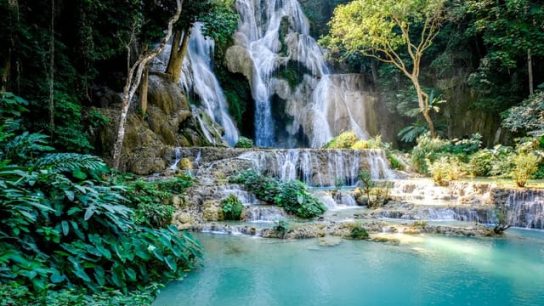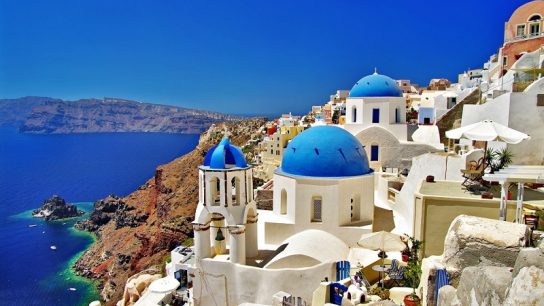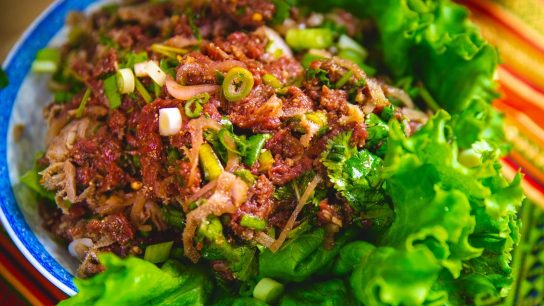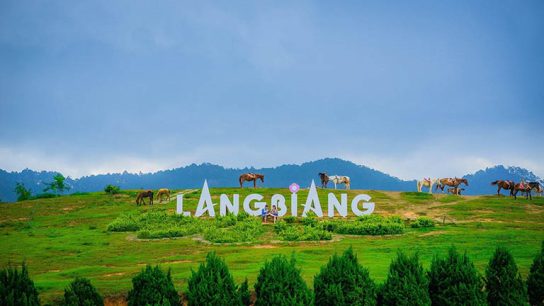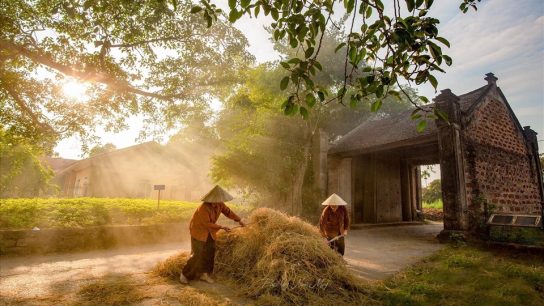When considering spiritual retreats and architectural marvels in Vietnam, Linh Phuoc Pagoda emerges as a paramount destination. Situated amidst the tranquil environs of Da Lat, this pagoda not only serves as a place of reverence but also stands as a testament to the region’s intricate craftsmanship and profound cultural legacy. Allow us to embark on a journey through the captivating realm of Linh Phuoc Pagoda, unveiling its historical narrative, primary attractions, and essential tips for your visit.

Overview of Linh Phuoc Pagoda
Situated at 120 Tu Phuoc in the Trai Mat area, a mere 8 kilometers from the heart of Da Lat city, Linh Phuoc Pagoda is fondly referred to as the “Ve Chai Pagoda” owing to its distinctive construction method employing glass bottles. The pagoda boasts a remarkable 49-meter dragon sculpture crafted from 12,000 glass bottles, epitomizing its unique architectural flair. Renowned for its intricate mosaic work embellishing every complex facet, Linh Phuoc Pagoda offers a visual spectacle for all who visit.
Linh Phuoc Pagoda exemplifies ingenious repurposing and artistic ingenuity. The painstaking mosaic designs fashioned from shards of ceramic and glass transmute mundane materials into extraordinary masterpieces. Each facet of the pagoda, from its towering statues to its elaborate murals, narrates tales steeped in Buddhist lore and Vietnamese heritage. The pagoda’s artistic and spiritual significance beckons thousands of visitors annually, eager to behold its splendor and immerse themselves in its serene ambiance.
History of Linh Phuoc Pagoda

The inception of Linh Phuoc Pagoda dates back to 1949, with completion achieved a year later in 1950. Throughout the ensuing decades, the pagoda has undergone multiple renovations and expansions. In 1990, Thuong Toa Thich Tam Vi spearheaded a substantial restoration endeavor, introducing numerous new structures and artworks. Overseeing the pagoda’s evolution have been five abbots, each instrumental in its development and spiritual enrichment.
- Hoa Thuong Thich Minh The (1951-1954): The inaugural abbot laid the groundwork for the pagoda’s spiritual practices.
- Hoa Thuong Thich An Hoa (1954-1956): The pagoda’s spiritual and physical advancement continued.
- Hoa Thuong Thich Quang Phat (1956-1959): emphasized community involvement and extended the pagoda’s influence.
- Hoa Thuong Thich Minh Duc (1959-1985): Oversaw the augmentation of the pagoda’s cultural and educational initiatives.
- Thuong Toa Thich Tam Vi (1985-present): orchestrated the notable restoration in 1990, incorporating significant structures and artworks.
The leadership of each abbot has left an indelible mark on Linh Phuoc Pagoda, solidifying its status as a pivotal cultural and religious landmark in Da Lat. The pagoda’s continual evolution mirrors the dynamic essence of Vietnamese Buddhism and underscores the community’s commitment to preserving its heritage.
How to Get There
Visiting Linh Phuoc Pagoda proves to be a straightforward endeavor. From the heart of Da Lat, one can opt for a convenient taxi or a thrilling motorbike ride, typically spanning a mere 20 minutes. Alternatively, local buses en route to Trại Mát also conveniently make stops near the pagoda. The Da Lat Railway offers a charming train ride to Tri Mát, then a short stroll to the pagoda, for those who enjoy scenic journeys.
- By Taxi or Motorbike: The most convenient mode of transportation to Linh Phuoc Pagoda is via taxi or motorbike. This swift journey allows visitors to immerse themselves in the surrounding splendor at their leisure. For the adventurous souls, motorbike rentals abound in Da Lat, offering a more exhilarating route.
- By Local Bus: For budget-conscious travelers, local buses present an economical option. Departing regularly from the central bus station in Da Lat, these buses heading towards Trại Mát offer an affordable means of reaching Linh Phuoc Pagoda. It’s advisable to confirm with the driver that the bus stops in the vicinity of the pagoda.
- By Train: Embarking on the Da Lat–Trại Mát Railway unveils a unique and picturesque passage to the pagoda. This train journey offers captivating vistas of Da Lat’s countryside, rendering the voyage as delightful as the destination itself. Upon reaching Trại Mát, a brief and scenic walk leads to Linh Phuoc Pagoda.
Main Attractions in Linh Phuoc Pagoda
The Linh Phuoc Pagoda boasts several captivating attractions that promise to enchant visitors with their splendor and significance.
Chinh Dien (Main Hall):
A true architectural marvel, the main hall of Linh Phuoc Pagoda mesmerizes with its intricate design and vibrant decor. Adorned with exquisite mosaics and vivid murals portraying scenes from Buddhist scriptures, the interior emanates a sense of reverence and tranquility

At its heart stands a majestic statue of the Buddha, surrounded by meticulously crafted altars and offerings. The dragon columns, adorned with an array of colorful ceramic pieces, infuse the space with a dynamic energy symbolizing strength and protection.
Hoa Long Vien Garden:

Among the pagoda’s most iconic features lies the Hoa Long Vien Garden, home to a remarkable 49-meter-long dragon sculpture crafted from 12,000 recycled glass bottles. This awe-inspiring creation showcases the pagoda’s dedication to environmental sustainability and serves as a serene haven for meditation and contemplation amidst the tranquil beauty of the surroundings.
Linh Thap (Seven-Story Tower):

Reaching skyward at 37 meters, Linh Thap stands tall as one of the pagoda’s tallest structures. Housing the majestic Dai Hong Chung bell, weighing an impressive 8.5 tons, this seven-story tower offers panoramic views of the pagoda and its lush environs to those who ascend its heights. Each tower level is adorned with unique statues and artifacts that offer profound insights into Buddhist teachings and Vietnamese culture.
Quan The Am Bo Tat Statue:

Dominating the landscape with its imposing presence is the towering statue of Quan The m Bo Tat (Avalokiteshvara), the embodiment of compassion and mercy. Crafted entirely from white jade and standing at an impressive 17 meters, this statue serves as a beacon of solace and protection for devotees who come to offer prayers and seek blessings.
The 18 Arhats:
Scattered throughout the pagoda grounds are statues of the 18 Arhats, revered Buddhist figures who have attained enlightenment. Each statue is a testament to Buddhist teachings’ profound wisdom and virtues, meticulously crafted to convey their attributes. These statues are set amidst a tranquil garden and provide a serene sanctuary for contemplation and reflection.
Exhibition Hall:
Enriching the visitor experience is the pagoda’s exhibition hall, showcasing a captivating array of ancient pottery, precious stones, and intricate woodwork. Offering insights into Vietnam’s rich cultural heritage and artistic achievements, this collection provides a deeper understanding of the historical and cultural context surrounding the pagoda.
The Best Time to Visit Linh Phuoc Pagoda

Visiting Linh Phuoc Pagoda is a delightful experience any time of the year, but certain seasons offer more favorable conditions:
- Dry Season (November to March): Undoubtedly the prime time to explore Da Lat and Linh Phuoc Pagoda, the dry season offers idyllic weather conditions characterized by cool temperatures and minimal rainfall. This period coincides with a flurry of festivities, most notably the Lunar New Year (Tết), where the pagoda bursts to life with vibrant decorations, cultural performances, and special ceremonies, elevating your visit with an added layer of enchantment.
- Rainy Season (April to October): Despite the occasional heavy downpours, the rainy season unveils Da Lat’s verdant landscape, adorned with lush greenery and vibrant blooms. For those unfazed by sporadic rain, this season presents a tranquil and less crowded opportunity to immerse oneself in the pagoda’s serene ambiance. Remember to use an umbrella or raincoat to navigate the occasional showers.
Local Tips For You
To ensure a fulfilling visit to Linh Phuoc Pagoda, consider heeding the following local tips:
- Dress Modestly: As a revered place of worship, it is customary to dress modestly and respectfully. Opt for attire that covers shoulders and knees, avoiding shorts, sleeveless tops, or revealing clothing. Comfortable footwear is advisable, given the need for walking and ascending stairs during your exploration.
- Timing Your Visit: Maximize your experience by timing your visit during the early morning or late afternoon hours. This offers cooler temperatures, and the soft lighting during these times also provides optimal conditions for capturing memorable photographs. Furthermore, these periods typically witness fewer crowds, allowing for a more tranquil and immersive encounter with the pagoda’s beauty.
- Ringing the Bell: Embrace the opportunity to partake in a sacred tradition by ringing the Đại Hồng Chung bell housed within the Linh Tháp tower. Believed to usher in good fortune and blessings, the deep resonance of the bell resonates throughout the pagoda, enhancing its spiritual aura and leaving an indelible mark on your visit.
- Engage with Monks and Practitioners: Immerse yourself in the rich tapestry of the pagoda’s spiritual legacy by engaging with the local monks and practitioners. Their profound insights into the pagoda’s history, Buddhist tenets, and the symbolism behind its various structures and artifacts can offer invaluable perspectives, enriching your visit with newfound understanding and appreciation.
Duong Lam Ancient Village: A Timeless Journey into Vietnam's Past
Si Phan Don Laos: A Journey Through the Land of 4,000 Islands

